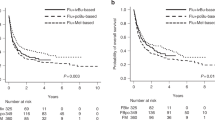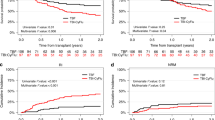Summary:
A total of 174 newly diagnosed adult acute myeloid leukaemia (AML) patients were treated in first complete remission (CR1) using modified TAM or a combination of triple-alkylating agents followed by autologous transplantation (AT). Cytogenetic risk groups were classified and most patients received mobilized peripheral blood stem/progenitor cells (PBSCs). The infused cell dose consisted of a median of 4.1±2 (range, 1.2–17.1)× 106/kg CD34+ cells. With a median follow-up of 51 months (range, 5–131 months) after CR1, the estimated 5-year disease-free survival (DFS) rate was 68 (95% confidence interval (CI), 63–73%) and the event-free survival rate at 5 years was 59 (95% CI, 54–64%). AML patients other than M3 subtype, the long-term DFS rate was 76, 33% for favourable and unfavourable risk groups, respectively. In all, 40 patients had relapses (40/174, 23%) at the median 15 months after CR1 (range, 8–66 months). Overall, seven patients (4%) died in connection with AT. The infused CD34+ cell dose (P=0.0389) was associated with survival by multivariate analysis. In conclusion, two novel conditioning regimens in AT are feasible for adults with variable risk AML followed for over a 10-year period.
This is a preview of subscription content, access via your institution
Access options
Subscribe to this journal
Receive 12 print issues and online access
$259.00 per year
only $21.58 per issue
Buy this article
- Purchase on Springer Link
- Instant access to full article PDF
Prices may be subject to local taxes which are calculated during checkout





Similar content being viewed by others
References
Zittoun RA, Mandelli F, Willemze R et al. Autologous or allogeneic bone marrow transplantation compared with intensive chemotherapy in acute myelogenous leukemia. N Engl J Med 1995; 332: 217–223.
Sierra J, Brunet S, Granena A et al. Feasibility and results of bone marrow transplantation after remission induction and intensification chemotherapy in de novo acute myeloid leukemia. Canadian Group for Bone Marrow Transplantation. J Clin Oncol 1996; 14: 1353–1363.
Stein AS, O'Donnell MR, Chai A et al. In vivo purging with high-dose cytarabine followed by high-dose chemoradiotherapy and reinfusion of unpurged bone marrow for adult acute myelogenous leukemia in first complete remission. J Clin Oncol 1996; 14: 2206–2216.
Cassileth PA, Harrington DP, Appelbaum F et al. Chemotherapy compared with autologous or allogeneic bone marrow transplantation in the management of acute myeloid leukemia in first remission. N Engl J Med 1998; 339: 1649–1656.
Tsimberidou AM, Stavroyianni N, Viniou N et al. Comparison of allogeneic stem cell transplantation, high-dose cytarabine, and autologous peripheral stem cell transplantation as postremission treatment in patients with de novo acute myelogenous leukemia. Cancer 2003; 97: 1721–1731.
Cahn JY, Souillet BG, Pico JL et al. The TAM regimen prior to allogeneic and autologous bone marrow transplantation for high-risk acute lymphoblastic leukemias: a cooperative study of 62 patients. Bone Marrow Transplant 1991; 7: 1–4.
Holmberg LA, Lemirer T, Rowley S et al. High-dose busulfan, melphalan and thiotepa followed by autologous peripheral blood stem cell (PBSC) rescue in patients with advanced stage III/IV ovarian cancer. Bone Marrow Transplant 1998; 22: 651–659.
Mitelman F ( ed.). ISCN 1995: An International System for Human Cytogenetic Nomenclature. Basel, Switzerland: S Karger, 1995.
Slovak ML, Kopecky KJ, Cassileth R et al. Karyotypic analysis predicts outcome of preremission and postremission therapy in adult acute myeloid leukemia: a Southwest Oncology Group/Eastern Cooperative Oncology Group study. Blood 2000; 96: 4075–4083.
Park HS, Kim DW, Kim CC et al. Induction chemotherapy with Idarubicin plus N4-behenoyl-1-β-D-arabinofuranosylcytosine in acute myelogenous leukemia: a newly designed induction regimen – a prospective, cooperative multicenter study. Seminar Hematol 1996; 33 (Suppl. 3): 24–29.
Miller AB, Hoogstraten B, Staquet M, Winkler A . Reporting results of cancer treatment. Cancer 1981; 47: 207–214.
Amadori S, Testi AM, Arico M et al. Prospective comparative study of bone marrow transplantation and postremission chemotherapy for childhood acute myelogenous leukemia. J Clin Oncol 1993; 11: 1046–1054.
Ewing JC, Robertson JD, Kell WJ et al. Autologous peripheral blood stem cell transplantation in first remission adult acute myeloid leukaemia – an intention to treat analysis and comparison of outcome using a predictive model based on the MRC AML10 cohort. Hematology 2003; 8: 83–90.
Collisson EA, Lashkari A, Malone R et al. Long-term outcome of autologous transplantation of peripheral blood progenitor cells as postremission management of adult acute myelogenous leukemia in first complete remission. Leukemia 2003; 17: 2183–2188.
Weaver CH, Bensinger WI, Appelbaum F et al. Phase I study of high-dose busulfan, melphalan, thiotepa with autologous stem cell support in patients with refractory malignancies. Bone Marrow Transplant 1994; 14: 813–819.
Schiffman KS, Bensinger WI, Appelbaum FR et al. Phase II study of high-dose busulfan, melphalan and thiotepa with autologous peripheral blood stem cell support in patients with malignant disease. Bone Marrow Transplant 1996; 17: 943–950.
Holmberg LA, Demirer T, Rowley S et al. High-dose busulfan, melphalan and thiotepa followed by autologous peripheral blood stem cell (PBSC) rescue in patients with advanced stage III/IV ovarian cancer. Bone Marrow Transplant 1998; 22: 651–659.
Keating S, Suciu S, de Witte T et al. The stem cell mobilization capacity of patients with acute myeloid leukemia in complete remission correlates with relapse risk: results of the EORTC-GIMEMA AML-10 trial. Leukemia 2003; 17: 60–67.
Feller N, Schuurhuis GJ, van der Pol MA et al. High percentage of CD34-positive cells in autologous AML peripheral blood stem cell products reflects inadequate in vivo purging and low chemotherapeutic toxicity in a subgroup of patients with poor clinical outcome. Leukemia 2003; 17: 68–75.
Author information
Authors and Affiliations
Corresponding author
Rights and permissions
About this article
Cite this article
Kim, HJ., Min, WS., Eom, KS. et al. Autologous stem cell transplantation using modified TAM or combination of triple-alkylating agents conditioning regimens as one of the post-remission treatments in patients with adult acute myeloid leukemia in first complete remission. Bone Marrow Transplant 34, 215–220 (2004). https://doi.org/10.1038/sj.bmt.1704556
Received:
Accepted:
Published:
Issue Date:
DOI: https://doi.org/10.1038/sj.bmt.1704556
Keywords
This article is cited by
-
Quantitative fragment analysis of FLT3-ITD efficiently identifying poor prognostic group with high mutant allele burden or long ITD length
Blood Cancer Journal (2015)
-
Identification of molecular and cytogenetic risk factors for unfavorable core-binding factor-positive adult AML with post-remission treatment outcome analysis including transplantation
Bone Marrow Transplantation (2014)
-
Experiences of t-PA use in moderate-to-severe hepatic veno-occlusive disease after hematopoietic SCT: is it still reasonable to use t-PA?
Bone Marrow Transplantation (2013)
-
Normal karyotype mosaicism in adult AML patients with adverse-risk and undefined karyotype: preliminary report of treatment outcomes after hematopoietic stem cell transplantation
International Journal of Hematology (2013)
-
Overcoming various comorbidities by G-CSF-primed unmanipulated BM SCT in adult patients with AML
Bone Marrow Transplantation (2009)



